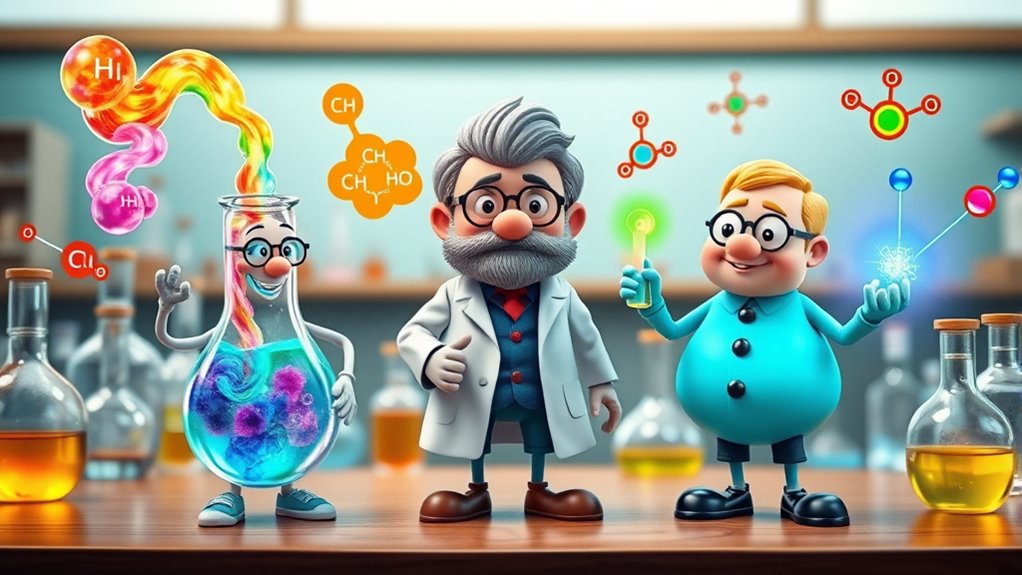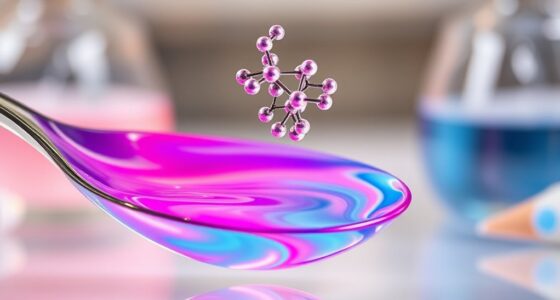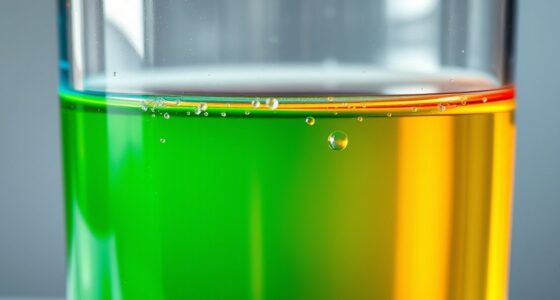Understanding acids involves exploring three main definitions. Arrhenius acids release H⁺ ions in water, making solutions acidic, but they don’t explain acid behavior outside aqueous environments. Brønsted-Lowry acids donate protons to bases, which accept them, broadening the scope. Lewis acids accept electron pairs, even without protons involved. Each approach offers unique insights into acidity. Keep exploring these theories to see how they compare and deepen your understanding of acid behavior in different reactions.
Key Takeaways
- Arrhenius defines acids as substances that increase H⁺ ions in water, while Brønsted-Lowry sees acids as proton donors and Lewis as electron pair acceptors.
- The Arrhenius model is limited to aqueous solutions, whereas Brønsted-Lowry and Lewis theories apply to broader, non-water systems.
- Brønsted-Lowry emphasizes proton transfer, explaining conjugate acids and bases, unlike Arrhenius’ focus on hydroxide and hydrogen ions.
- Lewis theory broadens acid-base concepts to include electron pair interactions, useful for reactions without proton transfer.
- Together, these theories provide a comprehensive understanding of acid behavior across different chemical environments.

Acids are substances that can donate protons or accept electron pairs, and understanding their behavior depends on the theoretical framework you use. When you’re exploring acids, it’s helpful to consider how they interact with other substances and how you can detect their presence. Acid-base indicators are tools that change color depending on the acidity or alkalinity of a solution, providing a visual cue of the acid’s strength. These indicators work within the pH scale, which measures how acidic or basic a solution is on a scale from 0 to 14. The lower the pH, the more acidic the solution, and the higher the pH, the more basic it is. Different theories of acids help you predict how acids will behave in various chemical reactions and how they influence the pH scale.
The Arrhenius definition is the simplest and most straightforward. It states that acids are substances that increase the concentration of hydrogen ions (H⁺) in aqueous solutions. When you add an acid according to Arrhenius, you’ll notice a decrease in pH, and you can often observe this change using acid-base indicators. For example, hydrochloric acid (HCl) dissociates in water to release H⁺ ions, making the solution more acidic.
This approach is easy to understand but limited to reactions involving water, so it doesn’t fully explain acid behavior in non-aqueous systems. It also doesn’t account for acids that react outside of aqueous environments or involve complex reactions.
The Brønsted-Lowry theory expands your understanding by describing acids as proton donors and bases as proton acceptors. This framework emphasizes the transfer of protons during reactions, which makes it more versatile than Arrhenius. When you work with Brønsted-Lowry acids, you can predict how they’ll react with bases in various scenarios, even outside aqueous solutions.
You might use acid-base indicators to determine the pH of a solution, helping you identify whether an acid has been neutralized or if the solution remains acidic or basic. This theory explains phenomena like conjugate acid-base pairs, giving you a broader perspective on acid strength and reactivity.
Finally, the Lewis theory takes a different approach by defining acids as electron pair acceptors and bases as electron pair donors. This perspective is especially useful in complex reactions where proton transfer isn’t obvious. Lewis acids can accept electron pairs from Lewis bases, forming coordinate bonds.
When you’re analyzing reactions involving these species, understanding their electron behavior helps you grasp how acids influence the pH scale indirectly, through their interactions with other molecules. Using acid-base indicators in such cases can help you track changes in acidity or basicity, even in non-traditional environments. Each theory offers a unique lens, helping you interpret acid behavior more holistically and apply that knowledge effectively across different chemical contexts.
Frequently Asked Questions
How Do Acids Differ in Strength Across the Three Theories?
You can gauge acid strength through pH measurement and acid-base indicators, which show how much an acid releases hydrogen ions. Strong acids completely ionize, resulting in a lower pH, while weak acids only partially ionize, giving a higher pH.
This concept applies across theories, but Brønsted‑Lowry and Lewis focus more on proton or electron pair donation, affecting how you interpret acid strength beyond just pH and indicators.
Can a Substance Be Classified as an Acid Under All Three Theories?
You might wonder if a substance qualifies as an acid under all three theories. The answer is yes; if it participates in acid-base reactions, it often has the right molecular structure to act as an acid in different contexts.
For example, it can donate protons, accept electron pairs, or produce H+ ions. These versatile properties allow a substance to be classified as an acid across all three theories.
How Do Conjugate Acids and Bases Relate in Brønsted-Lowry Theory?
Imagine mixing vinegar and baking soda; vinegar acts as an acid, and baking soda as a base, forming conjugate pairs.
In Brønsted-Lowry theory, acids donate protons to become conjugate bases, while bases accept protons to become conjugate acids.
Amphoteric substances can act as either, depending on the situation.
Acid-base indicators reveal these changes, helping you understand how conjugate acids and bases relate during reactions.
Are There Acids That Do Not Fit Any of These Models?
You might wonder if any acids don’t fit standard models. Yes, exotic acids exhibit non-classical behavior, so they don’t always align with Arrhenius, Brønsted‑Lowry, or Lewis definitions.
These acids can act unexpectedly, like stabilizing unusual structures or showing unique reactivity. Their behaviors challenge traditional concepts, highlighting the diversity of acid behavior beyond classical models.
How Do Lewis Acids Interact With Non-Protonic Compounds?
You wonder how Lewis acids interact with non-protonic compounds. They do this through metal coordination, where the Lewis acid accepts an electron pair from a non-protonic compound, forming a stable complex.
This process involves the Lewis acid acting as an electron pair acceptor, engaging with molecules that lack protons but have lone pairs, creating new bonds and stabilizing the structure.
This interaction highlights their versatility beyond traditional acid-base models.
Conclusion
Understanding acids through Arrhenius, Brønsted-Lowry, and Lewis is like exploring different windows into a complex house. Each perspective reveals unique details, helping you see the full picture of acid behavior. As you grasp these concepts, you’ll feel more confident, like a sailor steering uncharted waters with a trusted compass. Keep exploring, and you’ll uncover the secrets of acids, turning chemistry from a mystery into an exciting adventure.









